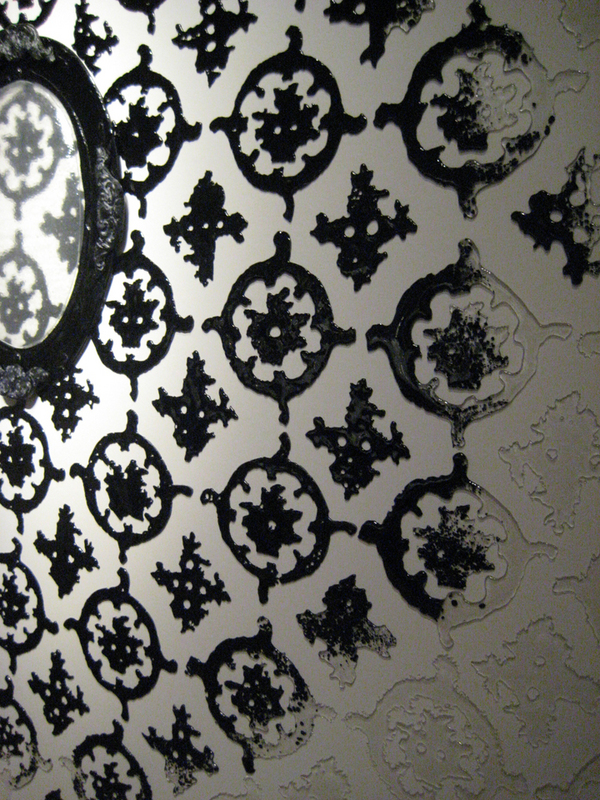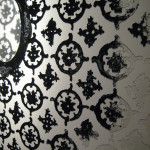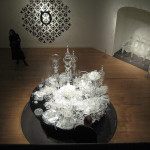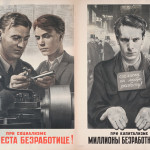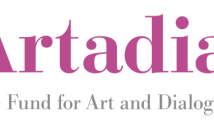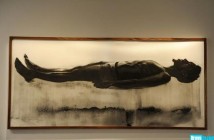BETH LIPMAN @ RISD & SOVIET POLITICAL ART @ BROWN
Last weekend I took a road trip (actually it was a train trip) to Providence. I went to check out the new wing at the museum at the Rhode Island School of Design. I detailed some of this trip on Big RED's blog last week. However, there were a couple of exhibitions I happened to see that I didn't get a chance to talk about in depth.
Alongside Dale Chihuly's exhibit at the RISD Museum was an installation by Beth Lipman. Titled After You're Gone, it is also a show of glass art but of a very different nature. Where Chihuly's work comes across as garish and tedious, Lipman's work has a quiet exactitude that was more striking and engaging. Lipman was brought in my RISD Museum director Hope Alswang and contemporary curator Judith Tannenbaum to create an exhibition based upon her explorations of the Museum's collections. She drew inspiration from RISD's rather large collection of American period rooms and decorative arts. The exhibition consists of several glass wallpaper pieces "based upon an 18th century French pattern," a glass settee, topiary sculptures, 500 snails, two squirrels, two portraits in glass, and a large circular sculpture placed in the center of the gallery. I initially read the exhibition as a hodge-podge of assorted pieces with no clear-cut theme but upon reflection I felt the work to be quite moving and fairly cohesive (there were a couple of things that didn't work for me). It is an engaging look at symbolism in the decorative arts of the late 18th century as it was manifested in wallpaper and still life paintings.
One major way that Lipman differentiates herself is that she works purely with black and white glass, eschewing any colour. This adds a layer of grace to the work that prevents it from devolving into perceptions of craft. Lipman walks the line between the decorative and the conceptual. Rather successfully, I might add. At first glance her "wallpaper" pieces appear to be simply that. But upon closer inspection one realizes that these are in fact three-dimensional interpretations of a pattern. This perceptual shift forces one to rethink the notion of decoration, commodity production, and historical narrative. The wallpapers are then complicated by the addition of the two glass "portraits" placed upon the wallpaper, as they would have been historically. These portraits are empty frames, leaving one to project or imagine a figure captured within. They sit framing and focusing one's attention upon the pattern with the complete absence of any identifying person.
There are also two alcoves constructed in the gallery. One holds the glass settee Settee (After Grinling Gibbons) and the other Mixed Fruit Centerpiece (III). Both of these spaces are evocative of those in mid-18th century middle-class American homes. These works fell flat for me. Perhaps it is simply that (thanks to living in New England) I have experienced these settings and references a bit too much. They seem merely clever and while I understand what she is trying to say (the exhibition booklet has an extensive interview with her that explains the work and her motivation) I felt "mheh" about them. They are certainly well crafted and aesthetically pleasing but did not hold my interest. I did like the somewhat prodigious piece that dominated the gallery: Laid Table (Still Life with Metal Picture. It consisted of a large round table placed in the center of the gallery and piled high with sculptures, fragment of sculptures and numerous pieces of glass detritus. I felt that this work was the only one that directly challenged notions of the still life painting. By using clear class the objects upon fade and resist attempts at grasping meaning. They are ephemeral. They float across the table. In stark contrast to the evident symbolism in decorative painting of the 18th century this work lacks any symbolic weight except that of its very referent. It symbolizes what it is a symbol of. It is this work and the concept behind it that elevates that work beyond the confines of "craft" and "decorative" arts. Lipman doesn't demean or dismiss such categories; she simply looks past them. And it is in this interesting juxtaposition of her work and Chihuly's that enables one to see the possibilities of art that is glass.
While in Providence I also had the chance to see Views and Re-Views: Soviet Political Posters and Cartoons, which was up at the Bell Gallery at Brown University. I strongly recommend this show. It was one of the most fascinating graphic exhibitions I've ever seen. It consisted of "posters, cartoons, photomontages, and postcards spanning more than six decades, from the time of the Russian Civil War (1918–21) into the late Soviet period." And quite a few of them were quite striking in their critique of Western capitalistic society. These were especially poignant given that capitalism was collapsing around our heads this past week.
One of my favourites was a poster circa 1952 that depicts famed banker J.P.Morgan striding across a city on the bodies of what are presumably workers. The background is a deep red while the city is awash in a deep sea of dark scarlet that I imagine is meant to represent blood. This poster, by Adolf Hoffmeister, is a fascinating portrayal given that J.P. Morgan (the bank) is one of the few left. There is also a poster of John D. Rockefeller from the same year that is equally unflattering. Another telling image is "In socialism, there is no place for unemployment! In capitalism, there are millions of unemployed!" by Viktor Koretsky from 1950. It is a diptych where one image shows two industrious workers in a factory and the other has a man possibly standing in Times Square, facing the viewer with his hands out while the wealthy gentlemen in top hats and coats walk by ignoring him. Again, this was especially compelling in light of our economic crash. This is a rare opportunity and a rare time to view this kind of cultural critique from a nation and ideology that has experienced its own crash. All the works in the exhibition are from a private collection so have rarely been exhibited (if ever). Brown History Professor Tom Gleason writes in the essay accompanying the show "in an age in which the worldwide image of the United States is at an all time low, it is interesting to confront these critical images from an earlier time, now emptied of any serious, practical challenge. Do we want to simply write them off as Communist propaganda? Or ought we to ask ourselves whether we can learn anything from contemplating such criticisms soberly?" In this exhibition one is confronted by criticisms that are hard to refute right now. It is a thought-provoking experience.
- Beth Lipman, Wallpaper (detail), kiln-formed glass, 2008.
- Beth Lipman, After You’re Gone, 2008. Installation view.
- Viktor Koretsky, In socialism, there is no place for unemployment! In capitalism, there are millions of unemployed!, lithograph,1950.
"After You're Gone" is on view through January 18th, 2009 at the Museum of Art at Rhode Island School of Design.
Views and Re-Views: Soviet Political Posters and Cartoons
"Views and Re-Views: Soviet Political Posters and Cartoons" is on view through October 19th at the David Winton Bell Gallery at Brown University.
All images are by the author, with thanks to the David Winton Bell Gallery at Brown University.

